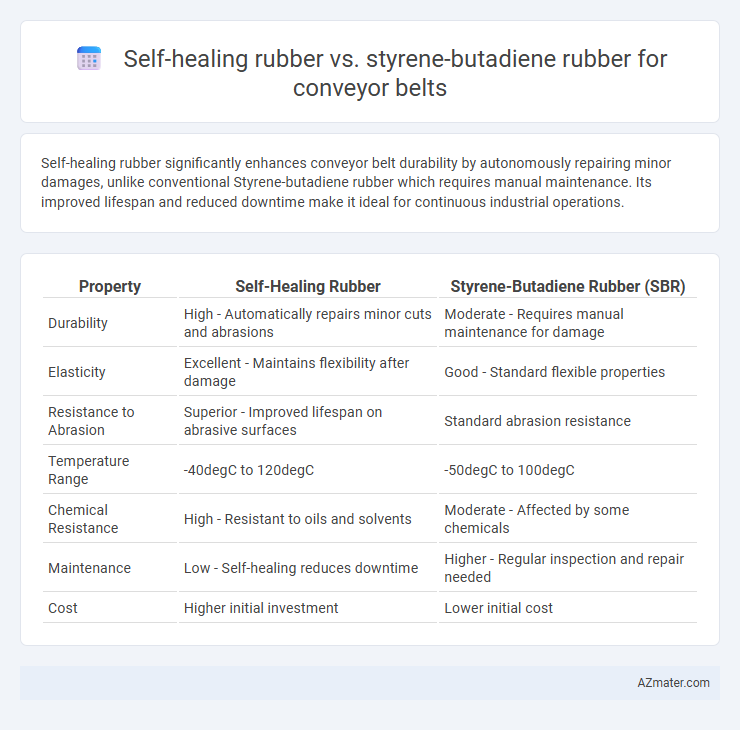Self-healing rubber significantly enhances conveyor belt durability by autonomously repairing minor damages, unlike conventional Styrene-butadiene rubber which requires manual maintenance. Its improved lifespan and reduced downtime make it ideal for continuous industrial operations.
Table of Comparison
| Property | Self-Healing Rubber | Styrene-Butadiene Rubber (SBR) |
|---|---|---|
| Durability | High - Automatically repairs minor cuts and abrasions | Moderate - Requires manual maintenance for damage |
| Elasticity | Excellent - Maintains flexibility after damage | Good - Standard flexible properties |
| Resistance to Abrasion | Superior - Improved lifespan on abrasive surfaces | Standard abrasion resistance |
| Temperature Range | -40degC to 120degC | -50degC to 100degC |
| Chemical Resistance | High - Resistant to oils and solvents | Moderate - Affected by some chemicals |
| Maintenance | Low - Self-healing reduces downtime | Higher - Regular inspection and repair needed |
| Cost | Higher initial investment | Lower initial cost |
Introduction to Conveyor Belt Materials
Self-healing rubber offers advanced durability by autonomously repairing minor damages, significantly extending conveyor belt lifespan compared to traditional Styrene-butadiene rubber (SBR), which is widely used due to its excellent abrasion resistance and affordability. Conveyor belts require materials with high tensile strength, flexibility, and resistance to wear, heat, and chemicals, where SBR balances performance and cost effectively. Innovations in self-healing rubber address common conveyor belt failures by reducing downtime and maintenance needs, making them a promising alternative in demanding industrial applications.
Overview of Self-Healing Rubber Technology
Self-healing rubber technology incorporates microcapsules or dynamic covalent bonds that enable automatic repair of cuts and abrasions, significantly extending conveyor belt lifespan and reducing maintenance downtime. Unlike Styrene-butadiene rubber, which offers excellent abrasion resistance and flexibility but requires manual patching, self-healing rubber continuously restores mechanical integrity without external intervention. This innovation enhances operational efficiency by minimizing belt replacement frequency and improving system reliability in harsh industrial environments.
Properties of Styrene-Butadiene Rubber (SBR)
Styrene-butadiene rubber (SBR) exhibits exceptional abrasion resistance, high tensile strength, and excellent aging stability, making it a reliable choice for conveyor belt applications. Its ability to maintain flexibility under a wide temperature range and resist wear from continuous friction enhances conveyor performance and lifespan. The copolymer structure provides strong resistance to heat, oxidation, and chemical exposure, ensuring durability in demanding industrial environments.
Durability Comparison: Self-Healing Rubber vs SBR
Self-healing rubber exhibits superior durability compared to styrene-butadiene rubber (SBR) in conveyor belt applications due to its inherent ability to autonomously repair micro-cracks and cuts, extending service life and reducing maintenance frequency. SBR, while widely used for its abrasion resistance and cost-effectiveness, lacks self-repairing mechanisms, making it prone to faster degradation under continuous mechanical stress and harsh environments. The enhanced resilience of self-healing rubber significantly improves operational uptime and lowers lifecycle costs in industrial conveyor systems.
Maintenance and Repair Costs
Self-healing rubber significantly reduces maintenance and repair costs for conveyor belts by automatically repairing minor cuts and abrasions, minimizing downtime and labor expenses. Styrene-butadiene rubber (SBR), while durable, often requires frequent manual repairs and inspections due to its inability to self-repair, leading to higher long-term operational costs. The advanced self-healing properties enhance conveyor belt longevity and reliability, optimizing overall maintenance budgets compared to conventional SBR materials.
Performance in Harsh Environments
Self-healing rubber significantly enhances conveyor belt longevity by autonomously repairing micro-cracks and abrasions, reducing downtime in harsh environments with extreme temperatures, chemicals, and abrasive materials. Styrene-butadiene rubber (SBR) offers excellent abrasion resistance and mechanical strength but lacks intrinsic self-repair capabilities, leading to faster degradation under continuous stress. Self-healing rubber's superior resilience and maintenance ease make it ideal for demanding industrial conveyor systems exposed to corrosive or high-wear conditions.
Sustainability and Environmental Impact
Self-healing rubber for conveyor belts significantly reduces waste and extends product lifespan by autonomously repairing damage, leading to lower material consumption compared to traditional Styrene-butadiene rubber (SBR). SBR, while durable and cost-effective, generates more environmental impact due to frequent replacements and energy-intensive manufacturing processes. The shift to self-healing rubber supports sustainability goals by minimizing landfill waste, reducing carbon emissions, and promoting resource efficiency in industrial applications.
Applications and Industry Adoption
Self-healing rubber offers enhanced durability and resistance to abrasion and cuts, making it ideal for conveyor belts used in harsh environments such as mining and heavy industry. Styrene-butadiene rubber (SBR) remains widely adopted due to its cost-effectiveness and versatility in general material handling and light industrial applications. Industries prioritizing reduced downtime and maintenance costs increasingly favor self-healing rubber technology for conveyor belts to improve operational efficiency.
Cost-Effectiveness Analysis
Self-healing rubber offers significant long-term cost savings for conveyor belts by reducing downtime and maintenance expenses through its intrinsic ability to repair micro-cracks automatically. Styrene-butadiene rubber (SBR), while being a lower upfront cost option, incurs higher maintenance and replacement costs due to its limited durability under continuous abrasion and mechanical stress. Evaluating lifecycle costs reveals that self-healing rubber provides a more cost-effective solution in high-wear industrial conveyor applications despite its initially higher price.
Future Trends in Conveyor Belt Materials
Self-healing rubber represents a significant advancement over traditional Styrene-butadiene rubber in conveyor belt applications by offering enhanced durability and reduced maintenance costs through its intrinsic ability to repair minor damages autonomously. Future trends in conveyor belt materials emphasize smart composites incorporating self-healing polymers combined with nano-fillers to improve elasticity, wear resistance, and lifespan in harsh industrial environments. Innovations in polymer chemistry and nanotechnology continue to drive the development of conveyor belts that minimize downtime and optimize operational efficiency in mining, manufacturing, and logistics sectors.

Infographic: Self-healing rubber vs Styrene-butadiene rubber for Conveyor belt
 azmater.com
azmater.com